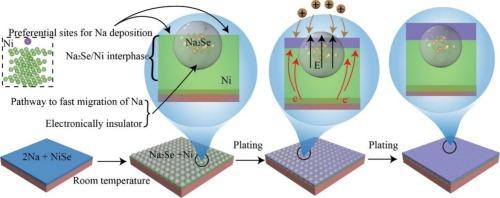A functional self-assembled layer with preferential sodium adsorption sites for ultra-stable sodium metal batteries
IF 13.2
1区 工程技术
Q1 ENGINEERING, CHEMICAL
引用次数: 0
Abstract
Generating a resilient and stable solid electrolyte interphase (SEI) is critical to enable dendrite-free sodium (Na) metal anodes; however, sustaining SEI stability at high current densities remains a significant obstacle. Here, an advanced ex-situ structural design composed of Na2Se and nickel metal (Na2Se/Ni) is proposed to achieve an interfacial regulating ionic flux system and obstruct dendrite growth. The highly sodiophilic Ni metal provides preferential sites for Na adsorption, preventing fracture and reducing volume expansion, while the Na2Se component offers pathways to fast migration of Na+ through the artificial layer. The designed SEI layer exhibits high mechanical stability, significant ionic conductivity, low nucleation overpotential, and low activation energy, which facilitate the redistribution of Na+ flux and promote homogeneous Na deposition. Additionally, theoretical calculations suggest that the Na2Se/Ni layer can reduce the kinetic barriers for rapid Na+ transport, resulting in decreased impedance. Consequently, the symmetric NS@Na cells demonstrate an extended cycle life (3600 h at 2 mA cm−2/1 mAh cm−2, 3900 h at 1 mA cm−2/1 mAh cm−2, and 750 h at 4 mA cm−2/1 mAh cm−2) with low voltage hysteresis. Furthermore, the full cell, coupled with a Na3V2(PO4)3 (NVP) cathode, offers an exceptionally long lifespan (5000 cycles) at 5C with a capacity of >90 mAh g−1. This work paves the way for a new and promising approach to stabilizing sodium metal anodes with straightforward and cost-effective interfacial layers.

用于超稳定钠金属电池的具有优先钠吸附位点的功能自组装层
生成弹性和稳定的固体电解质间相(SEI)是实现无枝晶钠(Na)金属阳极的关键;然而,在高电流密度下保持SEI稳定性仍然是一个重大障碍。本文提出了一种由Na2Se和镍金属(Na2Se/Ni)组成的先进的非原位结构设计,以实现界面调节离子通量体系,阻碍枝晶生长。高度亲钠的Ni金属为Na的吸附提供了优先的位置,防止了断裂和减少了体积膨胀,而Na2Se成分为Na+通过人工层的快速迁移提供了途径。所设计的SEI层具有高的机械稳定性、显著的离子电导率、低的成核过电位和低的活化能,有利于Na+通量的重新分配,促进Na的均匀沉积。此外,理论计算表明,Na2Se/Ni层可以降低Na+快速传输的动力学障碍,从而降低阻抗。因此,对称NS@Na细胞证明延长循环寿命(3600 h 2 马 厘米−mAh 2/1厘米−2,3900 h 1马 厘米−mAh 2/1厘米−2,和750年 h 4马 厘米−mAh 2/1厘米−2)与低电压滞后。此外,完整的电池与Na3V2(PO4)3 (NVP)阴极相结合,在5C下提供了超长的寿命(5000 循环),容量为>;90 mAh g - 1。这项工作为稳定金属钠阳极的一种新的、有前途的方法铺平了道路,这种方法具有简单和经济的界面层。
本文章由计算机程序翻译,如有差异,请以英文原文为准。
求助全文
约1分钟内获得全文
求助全文
来源期刊

Chemical Engineering Journal
工程技术-工程:化工
CiteScore
21.70
自引率
9.30%
发文量
6781
审稿时长
2.4 months
期刊介绍:
The Chemical Engineering Journal is an international research journal that invites contributions of original and novel fundamental research. It aims to provide an international platform for presenting original fundamental research, interpretative reviews, and discussions on new developments in chemical engineering. The journal welcomes papers that describe novel theory and its practical application, as well as those that demonstrate the transfer of techniques from other disciplines. It also welcomes reports on carefully conducted experimental work that is soundly interpreted. The main focus of the journal is on original and rigorous research results that have broad significance. The Catalysis section within the Chemical Engineering Journal focuses specifically on Experimental and Theoretical studies in the fields of heterogeneous catalysis, molecular catalysis, and biocatalysis. These studies have industrial impact on various sectors such as chemicals, energy, materials, foods, healthcare, and environmental protection.
 求助内容:
求助内容: 应助结果提醒方式:
应助结果提醒方式:


